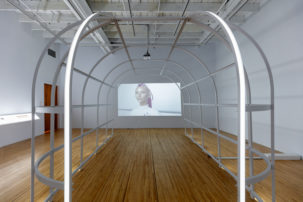In the same way that text uses formal conventions—grammar, syntax and typeface—to propose complex ideas on a flat page, words rendered on the large vertical surface of an art gallery’s walls transform text into a potentially visceral and visual experience.
These types of transformations are highlighted in the group exhibition “Giving Notice: Words on Walls,” where curator Peter Dykhuis features artists informed by commercial sign-making vernacular: hand-painted letters, custom vinyl and conventional typefaces, to name a few such elements.
Much of the work in this exhibition tackles the idea of “giving notice” via its political and commercial-advertising senses: it brings attention to ideas, pulls them out of context and exposes them while challenging existing relationships with common signage. Other works, like Gordon Lebredt’s installation Afterthoughts: a reading room–towards a different tropology, address the metaphysical; in this work, Lebredt uses words on walls to stage an encounter between French theorist Georges Bataille and American artist Robert Smithson.
In Garry Neill Kennedy’s new wall painting Redacted (The Colvin Memos), the artist revisits the colour scheme from 2007’s The Colours of Citizen Arar, which referred to the torture of Mahar Arar during his ordeal in a Syrian prison. In that earlier work, Kennedy’s choice of paint colours were related to those that Arar referenced in a 2006 government inquiry: fluorescent-orange prison jumpsuits, black wires used for torture and the blue colour of his injuries from abuse. Redacted encloses viewers in a small alcove of the gallery, surrounding them with abstract text fragments and related colour fields. The wall painting represents an email memo written by Canadian diplomat Richard Colvin; the memo reportedly exposed the torture of Afghan detainees, but its public release had any incriminating details completely blocked out. No pertinent information can be drawn from it.
With one line of black text on a white wall, Lawrence Weiner is represented by a piece from the Nova Scotia College of Art and Design’s collection. 5 Gallons Water Base Tempera Paint Poured Directly Upon The Floor And Allowed To Remain For The Duration Of The Exhibition was originally executed in 1969 at NSCAD’s Anna Leonowens Gallery and adds a historical reference point to the show. The form proposed by this text can exist in the mind of the viewer as easily as it can be executed in a gallery.
Micah Lexier’s Self Portrait As A Wall and his collaboration with Christian Bök, Two Equal Texts, bring to the show some of the artist’s stark, personal and descriptive conceptualism, opening up a dialogue between some of the other wall works by inviting viewers to insert themselves into the work and consider the length of their own lives.
The large and colourful Inspiring, by Cathy Busby, is seen as soon as one walks down the stairs into the gallery, and it’s the only work that makes reference to the gallery itself. It uses Dalhousie University’s advertising slogan “Inspiring Minds” as a starting point and then lists 13 other inspirational taglines—six gathered from Dalhousie’s academic competitors and seven from the corporate world. Standing below Busby’s work, the text is palpably out of reach; it towers overhead like the high ground that these institutions place themselves upon.
Given that this show tackles the idea of temporal work, of work which will only exist in part for the duration of the exhibition, one wonders if the walls of a gallery can really command such authority over the written word. Would these works still function beyond the gallery’s walls, or would they fall short—overshadowed by the monolith of commercial advertising and the Internet?










